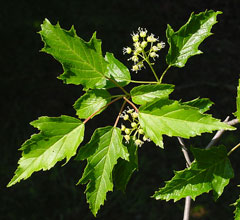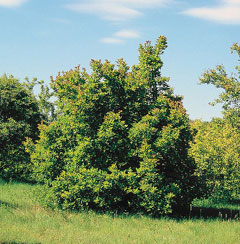 |
|
http://commons.wikimedia.org/wiki/User:Wouterhagens |
 |
|
Translate this page:
Summary
Bloom Color: Green, White.
Main Bloom Time: Early spring, Late spring, Mid spring. Form: Rounded, Spreading or horizontal.
Physical Characteristics

 Acer_tataricum is a deciduous Tree growing to 9 m (29ft 6in) at a medium rate.
Acer_tataricum is a deciduous Tree growing to 9 m (29ft 6in) at a medium rate.
See above for USDA hardiness. It is hardy to UK zone 4. It is in flower from May to June, and the seeds ripen in September. The species is monoecious (individual flowers are either male or female, but both sexes can be found on the same plant) and is pollinated by Insects.
Suitable for: light (sandy), medium (loamy) and heavy (clay) soils and can grow in heavy clay soil. Suitable pH: mildly acid, neutral and basic (mildly alkaline) soils. It can grow in semi-shade (light woodland) or no shade. It prefers moist soil.
UK Hardiness Map
US Hardiness Map
Synonyms
Plant Habitats
Edible Uses
The sap contains a certain amount of sugar and can either be used as a drink, or can be concentrated into a syrup by boiling off the water[74]. The syrup is used as a sweetener on many foods. The concentration of sugar is considerably lower than in the sugar maples (A. saccharum). The tree trunk is tapped in the early spring, the sap flowing better on warm sunny days following a frost. The best sap production comes from cold-winter areas with continental climates. Seed - cooked[105, 177]. The wings are removed and the seeds are then boiled[2].
References More on Edible Uses
Medicinal Uses
Plants For A Future can not take any responsibility for any adverse effects from the use of plants. Always seek advice from a professional before using a plant medicinally.
None known
References More on Medicinal Uses
The Bookshop: Edible Plant Books
Our Latest books on Perennial Plants For Food Forests and Permaculture Gardens in paperback or digital formats.

Edible Tropical Plants
Food Forest Plants for Hotter Conditions: 250+ Plants For Tropical Food Forests & Permaculture Gardens.
More

Edible Temperate Plants
Plants for Your Food Forest: 500 Plants for Temperate Food Forests & Permaculture Gardens.
More

More Books
PFAF have eight books available in paperback and digital formats. Browse the shop for more information.
Shop Now
Other Uses
The leaves are packed around apples, rootcrops etc to help preserve them[18, 20].
Special Uses
References More on Other Uses
Cultivation details
Landscape Uses:Container, Pollard, Standard, Specimen, Street tree. Of easy cultivation, it prefers a good moist well-drained soil on the acid side and a sunny position[11, 182]. Grows well in heavy clay soils. Chlorosis can sometimes develop as a result of iron deficiency when the plants are grown in alkaline soils, but in general maples are not fussy as to soil pH. Trees usually fruit abundantly in Britain[11]. A bad companion plant, inhibiting the growth of nearby plants[18, 20]. Special Features:Not North American native, Fragrant flowers, Inconspicuous flowers or blooms.
References Carbon Farming Information and Carbon Sequestration Information
Temperature Converter
Type a value in the Celsius field to convert the value to Fahrenheit:
Fahrenheit:
The PFAF Bookshop
Plants For A Future have a number of books available in paperback and digital form. Book titles include Edible Plants, Edible Perennials, Edible Trees,Edible Shrubs, Woodland Gardening, and Temperate Food Forest Plants. Our new book is Food Forest Plants For Hotter Conditions (Tropical and Sub-Tropical).
Shop Now
Plant Propagation
Seed - best sown as soon as it is ripe in a cold frame, it usually germinates in the following spring. Pre-soak stored seed for 24 hours and then stratify for 2 - 4 months at 1 - 8°c. It can be slow to germinate. The seed can be harvested 'green' (when it has fully developed but before it has dried and produced any germination inhibitors) and sown immediately. It should germinate in late winter. If the seed is harvested too soon it will produce very weak plants or no plants at all[80, 113]. When large enough to handle, prick the seedlings out into individual pots and grow them on until they are 20cm or more tall before planting them out in their permanent positions. Layering, which takes about 12 months, is successful with most species in this genus. Cuttings of young shoots in June or July. The cuttings should have 2 - 3 pairs of leaves, plus one pair of buds at the base. Remove a very thin slice of bark at the base of the cutting, rooting is improved if a rooting hormone is used. The rooted cuttings must show new growth during the summer before being potted up otherwise they are unlikely to survive the winter.
Other Names
If available other names are mentioned here
Native Range
TEMPERATE ASIA: Afghanistan (north), Turkey, Armenia, Azerbaijan, Georgia, Kazakhstan (east), Tajikistan, Uzbekistan, Mongolia (southeast), China (Heilongjiang Sheng, Henan Sheng, Hebei Sheng, Gansu Sheng, Jilin Sheng, Liaoning Sheng, Shanxi Sheng, Shaanxi Sheng, Nei Mongol Zizhiqu, Xinjiang Uygur Zizhiqu (west)), Japan (Hokkaidô, Honshu, Kyushu, Shikoku), Korea, North EUROPE: Austria, Hungary, Ukraine (incl. Krym), Former Yugoslavia, Romania
Weed Potential
Right plant wrong place. We are currently updating this section.
Please note that a plant may be invasive in one area but may not in your area so it’s worth checking.
Conservation Status
IUCN Red List of Threatened Plants Status :

Growth: S = slow M = medium F = fast. Soil: L = light (sandy) M = medium H = heavy (clay). pH: A = acid N = neutral B = basic (alkaline). Shade: F = full shade S = semi-shade N = no shade. Moisture: D = dry M = Moist We = wet Wa = water.
Expert comment
Author
L.
Botanical References
1193200
Links / References
For a list of references used on this page please go here
Readers comment
| Add a comment |
|
If you have important information about this plant that may help other users please add a comment or link below. Only comments or links that are felt to be directly relevant to a plant will be included. If you think a comment/link or information contained on this page is inaccurate or misleading we would welcome your feedback at [email protected]. If you have questions about a plant please use the Forum on this website as we do not have the resources to answer questions ourselves.
* Please note: the comments by website users are not necessarily those held by PFAF and may give misleading or inaccurate information.
To leave a comment please Register or login here All comments need to be approved so will not appear immediately.
|
|